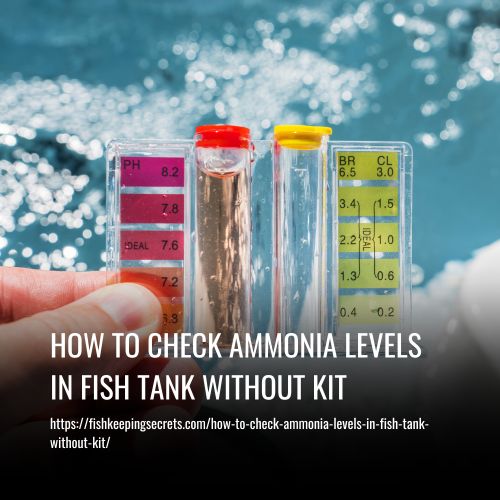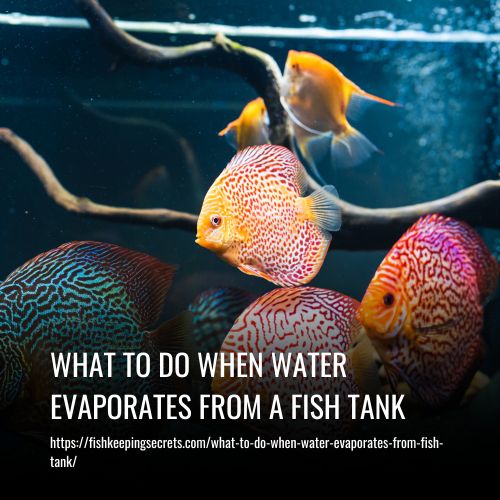How To Check Ammonia Levels In Fish Tank Without Kit
This post contains affiliate links. As an Amazon Associate, we earn from qualifying purchases.
One way to check the ammonia levels in your fish tank without a kit is to observe the behavior of your fish. If they are gasping for air at the surface or staying close to the filter, it may be a sign of high ammonia levels. Another method is to monitor the water quality by checking for cloudiness or unusual odors that can indicate high levels of toxins.
You could also try using household items like baking soda or vinegar to check for changes in pH levels, which can affect ammonia toxicity. However, it’s recommended to use a test kit for accurate measurements and proper monitoring of ammonia levels in your fish tank.

How to Test Fish Tank Water Without a Kit
Testing fish tank water is crucial to ensure the health of your aquatic pets. While test kits are an easy and reliable way to do this, they can be expensive and not always readily available. We have produced a guide discussing the ways to assess the water in your tank without utilizing a test kit.
One method involves using household items like white vinegar and baking soda, while another technique involves observing the appearance and behavior of your fish. However, it’s important to note that these alternatives may not provide as accurate results as a test kit, so monitoring your aquarium regularly is key.
Please keep in mind that this information is not intended to replace veterinary advice for any health concerns with your fish, and seeking professional help is always recommended.
How Can I Test My Aquarium Water Without a Test Kit?
Testing your fish tank’s water is crucial for maintaining a healthy and safe environment for your aquatic pets. If you do not have a test kit readily available, there are still ways to check the quality of your water.
One option is to bring a water sample to your local pet store or Walmart for testing. It is worth looking into testing services offered by different stores, as some may be free whereas others may cost a small fee. Comparing the cost of testing to the price of test kits is suggested to make an informed decision.
However, keep in mind that a good all-around test kit specifically designed for aquarium use can usually be purchased for around $20 to $50. These kits typically test important aspects such as pH, ammonia, nitrate, and nitrite levels in the water.
Ultimately, investing in a reliable water tester is worth it if you plan on owning fish or already have fish in your care. Maintaining good water quality ensures that your aquatic pets remain healthy and happy.
Are There Ways to Tell If My Fish Tank Water Is Healthy?
There are various methods to determine the condition of fish tank water, but a testing kit is necessary for accurate results.
1. Behavioral Changes in Fish:
As a dedicated aquarium hobbyist, you know how important it is to maintain your fish’s health and happiness. You can tell a lot about the state of your tank by observing your fish’s behavior. Knowing the normal behaviors of aquarium life is essential for maintaining a successful aquarium.
It is important to monitor changes in the behavior of fish, as this may be an indication of poor living conditions such as elevated levels of ammonia, nitrate, or nitrite in the tank. If untreated, these can lead to stress or sickness for your fish.
If you notice unusual behaviors such as decreased appetite, gasping at the surface, hiding or darting around the tank, resting at the bottom for prolonged periods or difficulty swimming, heavy breathing, and red gills among others that could be signaling improper water conditions. If changing the water does not affect the symptoms shown by your fish, it may be time to call in a professional veterinarian who might request a 100mL sample of water from your aquarium to determine if any underlying diseases are causing similar behavior.
2. Cloudy Water:
Sometimes fish tank water turns cloudy, which can be caused by several factors such as gravel residue, bacterial bloom, algae growth, and dissolved constituents like silicates, phosphates, or heavy metals.
Although cloudy water is usually not harmful to fish and can clear up on its own within 2-3 days if you don’t see any improvements after 5-10 days there may be a problem with your tank’s water quality. If the level of the dissolved constituent in your tank is high, then you will notice high pH levels (alkaline) when you test the water. However, treating the water with conditioners usually improves the quality of the water.
Alternatively, using a reverse osmosis (RO) water filter to reduce and filter out solid substances and harmful minerals from your tank’s water can also help keep it healthy for your fish.
3. Green Water:
Green water is often a sign of excessive algal growth in your fish tank. This isn’t necessarily harmful to the fish and other aquatic creatures living in the tank, as some phytoplankton species are actually beneficial – Tetraselmis, Thalassiosira, Nannochloropsis, and Isochrysis remove phosphates and nitrates, oxygenate the water, and even consume carbon dioxide which helps stabilize the pH level of the tank. In fact, some aquarium owners opt to add phytoplankton species to their tanks voluntarily; they do so in order to help their fish live longer and healthier lives.
However, if nitrate or phosphate levels in your tank are too high due to any number of causes (overfeeding, overstocking the tank, decaying matter such as fish food or dead plants), then it’s time to take action. You can determine how problematic the build-up is by testing your aquarium water with a kit specifically made for this purpose – nitrate levels above 40mg/L (40ppm) or phosphate levels above 0.05mg/L (0.05ppm) demand immediate attention.
You can get rid of nitrate and phosphates by not overfeeding your pets, not overstocking your tank irrigation system using de-nitrate filter media, adding nitrogen-feeding live plants/rocks into your aquarium setup, or consulting a pet store/veterinarian first before investing water treatments & chemical additives that help reduce these levels.
What Should I Test?
If you’re wondering what all you should test for when maintaining an aquarium, the answer is simple: ammonia, nitrite, nitrate, pH, and phosphate. Ammonia levels should always be undetectable or no greater than 0.0ppm and nitrite must be undetectable or no higher than 0.0ppm as well.
As for Nitrate, it should not exceed 40 ppm. When it comes to pH, freshwater fish require a range of 6.5 to 7.5 while saltwater fish prefer something above 8. Lastly, Phosphate must not be above 0.05ppm. With these tests in check, any aquarium will remain healthy for your aquatic friends!
How Can I Reduce Ammonia From My Tank Water Naturally?
If you’re looking to reduce the ammonia in your fish tank, there are natural and effective methods you can use.
The quickest and most efficient way to reduce ammonia is to simply take out the dirty water, replace it with fresh water, and cycle it with beneficial bacteria. While this may sound drastic, it is one of the best ways to get rid of large amounts of ammonia immediately.
It’s also important to be mindful of overfeeding especially since excessive food or any other decaying organic matter can lead to an accumulation of ammonia in your tank. Additionally, keep track of your fish’s waste as it too will contain ammonia that needs to be filtered out.
If all else fails and you want a surefire way of knowing exactly how much ammonia is present in your tank water, then investing in a test kit from an aquarium store is a wise decision. Just be sure to observe your fish for any signs that could point towards high levels such as lethargy so you know when something needs to be addressed before the situation gets out of hand.
By following these simple steps you’ll have a happier aquatic environment where your fish can thrive!
FAQs
Testing the water in your tank for ammonia is an important step to take for the health of your aquarium. The easiest and most reliable way to do this at home is with an API Ammonia Test Kit. You can find these kits in any fish store and they are easy to use; all you need is a 5ml water sample, add 5 drops of the tester liquid from the kit, then compare the color to a chart that comes with the kit.
To maintain the health and safety of your fish, it is recommended to check for ammonia levels in your tank once a week. Checking for ammonia can be done with a simple kit.
If you suspect that ammonia is present in your water, pay attention to your fish’s behavior. Signs of ammonia exposure include lethargy, lack of appetite, floating at the bottom, or discoloration and marks on the gills. If any of these are observed, it is essential to act quickly.
Ammonia levels in water can be reduced by exchanging it with fresh, new water. It is important to ensure that the new water is from a reliable source.
Signs that ammonia levels may be high in an aquarium include lack of activity or appetite in the fish and fish floating at the bottom of the tank.
Conclusion:
Checking the ammonia levels of your fish tank is an important part of keeping your aquatic pets healthy. Performing this measurement without a kit may require some trial and error, but with a bit of patience, you should be able to find the right testing materials and obtain accurate results.
Being mindful of the changing ammonia levels in your aquarium will ensure that your fish stay safe and thrive in their environment.






